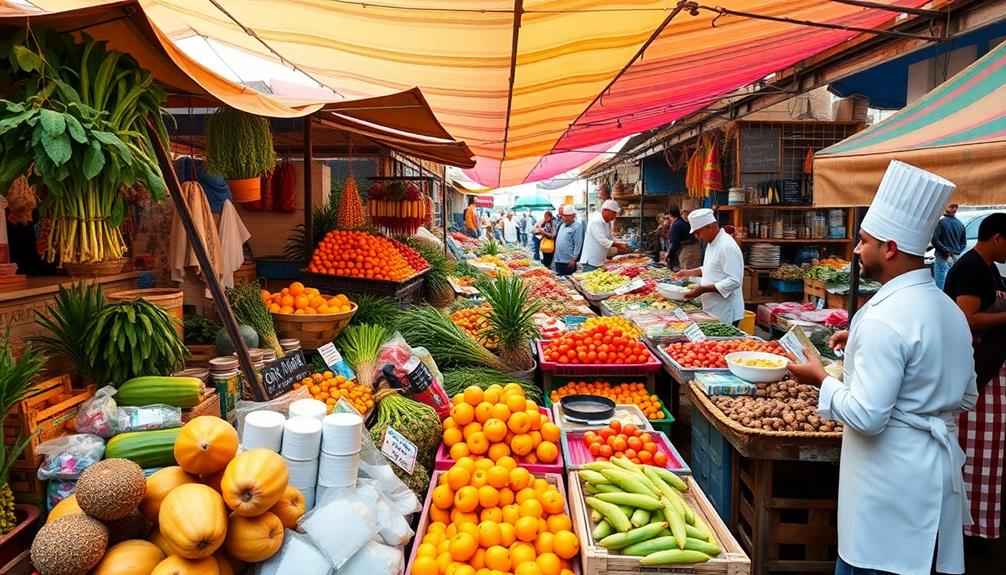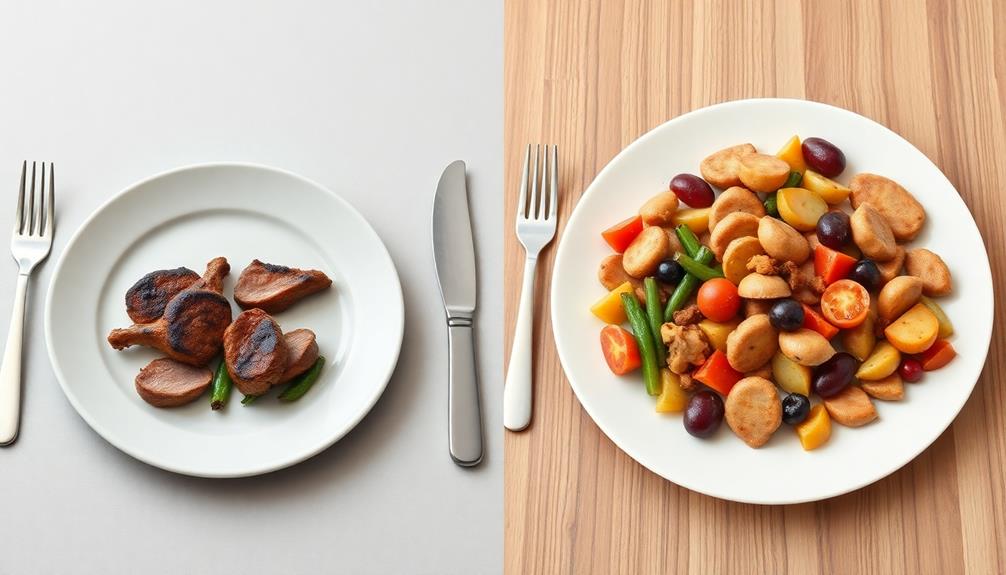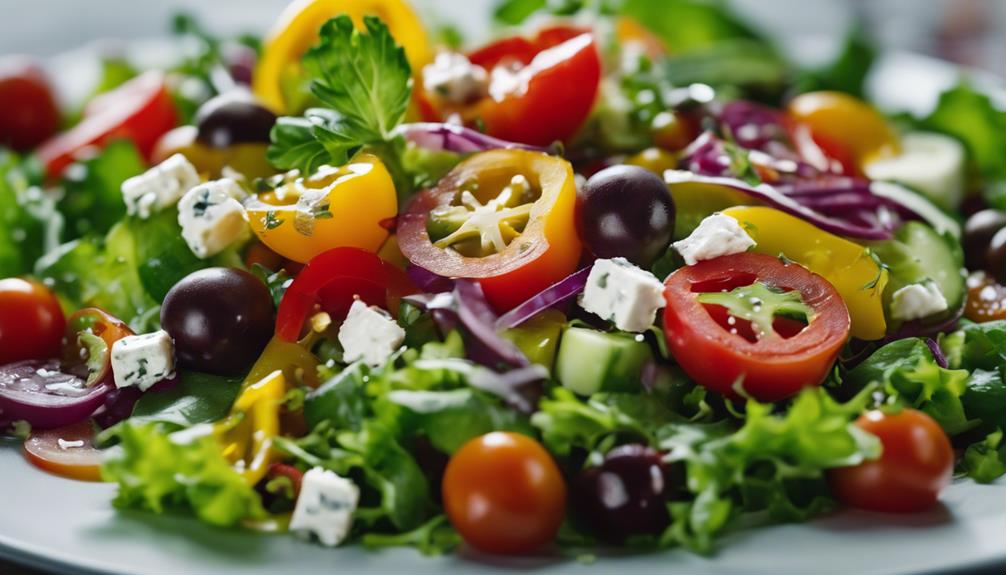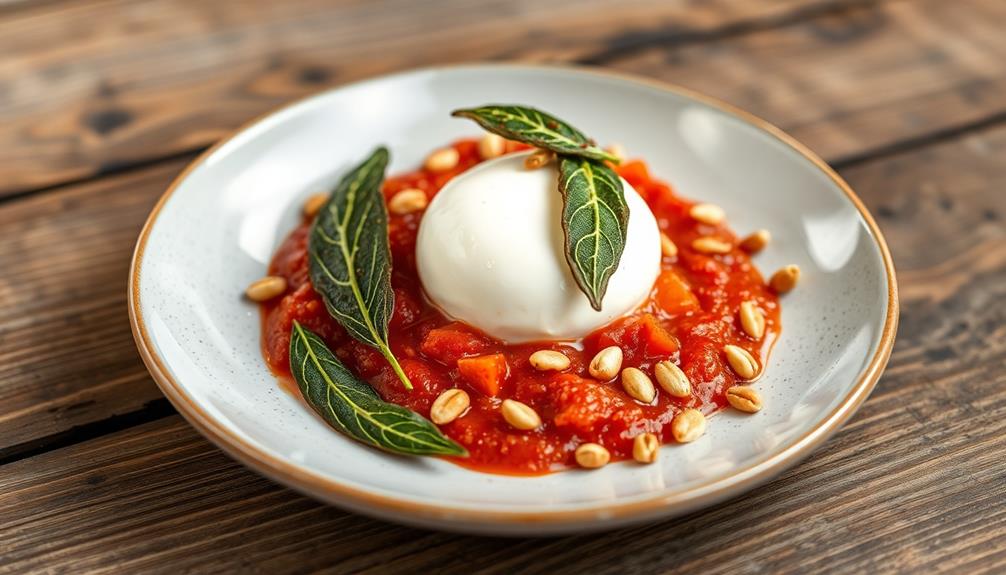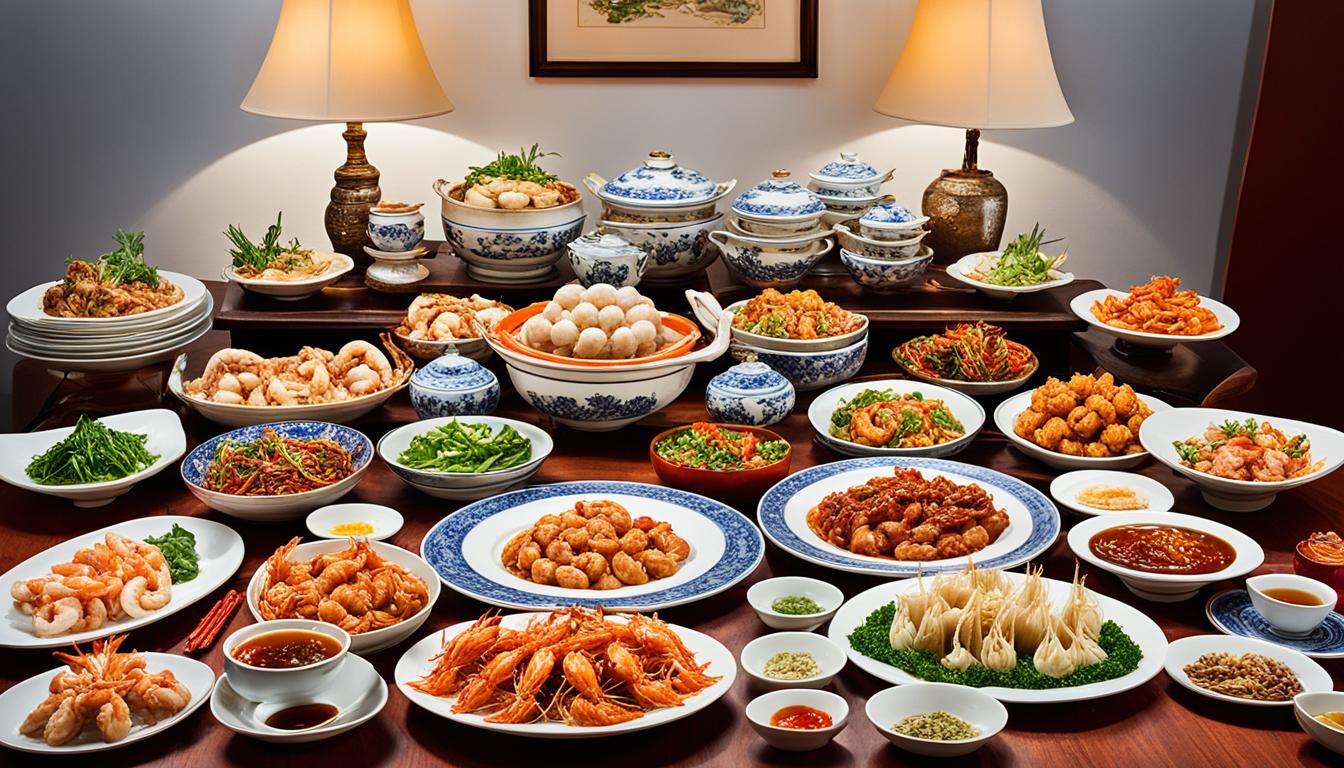Climate change is impacting global cuisine by changing ingredient availability and shifting traditional farming practices. You might notice familiar staples like rice and wheat becoming less reliable due to extreme weather events. Rising temperatures and altered rainfall patterns threaten fresh produce and seafood supplies, forcing chefs to adapt their recipes. These changes can even affect the nutritional quality of food, leading to deficiencies. As traditional cuisines evolve, local sourcing and sustainable practices are becoming essential. If you explore further, you'll discover how communities are creatively responding to these challenges in their culinary practices.
Key Takeaways
- Climate change leads to crop failures and reduced availability of staple foods, altering traditional diets worldwide.
- Changes in weather patterns impact the growth of key ingredients, complicating traditional culinary practices.
- Rising temperatures and CO2 levels threaten nutritional quality, leading to higher nutritional deficiencies in staple crops.
- Local food systems and sustainable practices are crucial for adapting culinary traditions and enhancing food security.
- Emerging fusion cuisines reflect the evolution of flavor profiles as communities adapt to ingredient scarcity and price increases.
Climate Change Overview

Climate change dramatically reshapes our world, and its impact on agriculture is profound. As global temperatures rise, you're likely to see extreme weather events like droughts and floods becoming more common. These events can drastically reduce agricultural productivity, leading to a potential 5-15% decrease in crop production for each degree Celsius increase in temperature.
Additionally, shifts in climate may affect the availability and quality of key ingredients used in traditional cuisines, such as the importance of cassava in Brazilian dishes. With a growing population and shifts toward resource-intensive diets, global food demand is projected to surge by 59-98% by 2050.
This escalating demand puts immense pressure on food security, especially in vulnerable regions where approximately 80% of crops are rainfed. Changing rainfall patterns threaten water availability for irrigation, complicating efforts to sustain crop yields.
Additionally, while elevated CO2 levels may boost crop yields, they come with a downside—lower nutritional quality. Key nutrients in staple crops like wheat and rice are expected to decline considerably, impacting the health of populations reliant on these foods.
As climate change continues to disrupt agriculture, vulnerable communities, particularly children and low-income families, face the highest risks from food production disruptions. Addressing these challenges is essential for ensuring a stable and nutritious food supply.
Impact on Agricultural Production

Rising global temperatures and shifting weather patterns directly threaten agricultural production, impacting food availability worldwide. Climate change impacts are projected to reduce global crop production by 5-15% for each degree Celsius rise in temperature. With around 80% of crops relying on rain, changes in rainfall patterns increase risks of droughts and flooding, especially in vulnerable regions like Africa, where agricultural productivity has already declined by 34%.
Here's a quick overview of how climate change affects food production:
| Factor | Impact on Crops | Consequence |
|---|---|---|
| Global Temperatures | Reduced yields by 5-15% per °C | Increased food insecurity |
| Weather Patterns | Increased droughts and flooding | Crop failure |
| Elevated CO2 Levels | Enhanced yields, lower nutrients | Nutritional deficiencies |
| Extreme Weather Events | Disruption in agricultural production | Threat to food availability |
These issues not only threaten the stability of food production but also lead to nutritional deficiencies in staple crops, making it essential to address the challenges posed by climate change.
Changes in Ingredient Availability

The shifting weather patterns caused by climate change are leading to significant changes in ingredient availability, which directly impacts culinary practices worldwide. As you navigate your kitchen, you might notice that key ingredients are becoming less reliable. This struggle stems from various factors:
- Crop failures due to extreme weather events like floods and droughts. For instance, the availability of essential spices used in dishes such as Mushroom Masala may be compromised, affecting the rich flavors of traditional recipes.
- Rising temperatures and altered rainfall patterns affecting the growth of grains, vegetables, herbs, and spices.
- Threatened fisheries resulting from changing ocean temperatures and acidification, jeopardizing fish and seafood supplies.
These challenges mean that staples like wheat, rice, and corn may become less available, disrupting your go-to recipes. You could find yourself searching for substitutes, as traditional herbs and spices might rise in price or become scarce.
This shift not only alters ingredient availability but also strains the culinary fabric of cultures reliant on these flavors. You may have to adapt to new ingredients, leading to innovative dishes that reflect a changing world.
As climate change continues to disrupt food systems, the way you cook and enjoy meals will inevitably transform, pushing you to explore new culinary horizons.
Effects on Culinary Traditions

As ingredient availability shifts due to climate change, culinary traditions are feeling the impact firsthand. You might notice that local ingredients you once relied on are becoming scarcer, forcing you to adapt your cooking methods. This shift not only alters your recipes but also changes the food supply landscape, leading to a dilution of traditional diets. This disruption has also sparked a re-evaluation of portion sizes through the years, as dwindling resources encourage more mindful consumption. Traditional large servings may need to give way to smaller, more sustainable portions that align with the availability of key ingredients. In turn, this trend challenges communities to preserve the essence of their culinary heritage while embracing necessary changes.
| Impact of Climate Change on Culinary Traditions | Examples |
|---|---|
| Reduced availability of staple foods | Rice in Southeast Asia |
| Shift in agricultural practices | Increased reliance on imports |
| Evolution of flavor profiles | Fusion cuisine emerging |
| Price increases for traditional ingredients | Local markets affected |
Extreme weather events and rising temperatures are reducing agricultural productivity, which can threaten the essence of your culinary heritage. In addition, higher CO2 levels may affect the nutritional quality of crops, pushing you to rethink your recipes. As communities adapt to climate impacts, you may find that your traditional dishes evolve into new forms, incorporating different ingredients. It's a challenging time for culinary traditions, but with resilience, you can keep the spirit of your cuisine alive.
Nutritional Quality Concerns

Given that climate change poses significant threats to the nutritional quality of our food, you may find yourself increasingly concerned about what's on your plate. As atmospheric CO2 levels rise, the protein content in staple crops like barley, wheat, and rice could drop by up to 30%.
This decline in nutritional quality isn't just about protein; essential vitamins and minerals may also decrease, leading to potential deficiencies for those who rely heavily on these foods. Additionally, the changing climate could impact the availability of diverse ingredients used in traditional cuisines, such as the rich flavors found in Chinese dishes like Red-Braised Pork Belly or Sichuan Cold Noodles.
Here are some key concerns to regard:
- Crop Production Decline: A 5-15% decrease in crop yields for each degree Celsius increase in temperature threatens food availability.
- Nutritional Deficiencies: Lower levels of essential nutrients in our staple foods can exacerbate health issues, especially in vulnerable populations.
- Food Insecurity: Climate change can intensify food insecurity, further complicating access to nutritious options.
As you navigate your meals, keep in mind how climate change may be reshaping the nutritional landscape of your diet and what it means for your health and well-being. Staying informed can help you make better food choices in an uncertain future.
Resilience of Local Food Systems
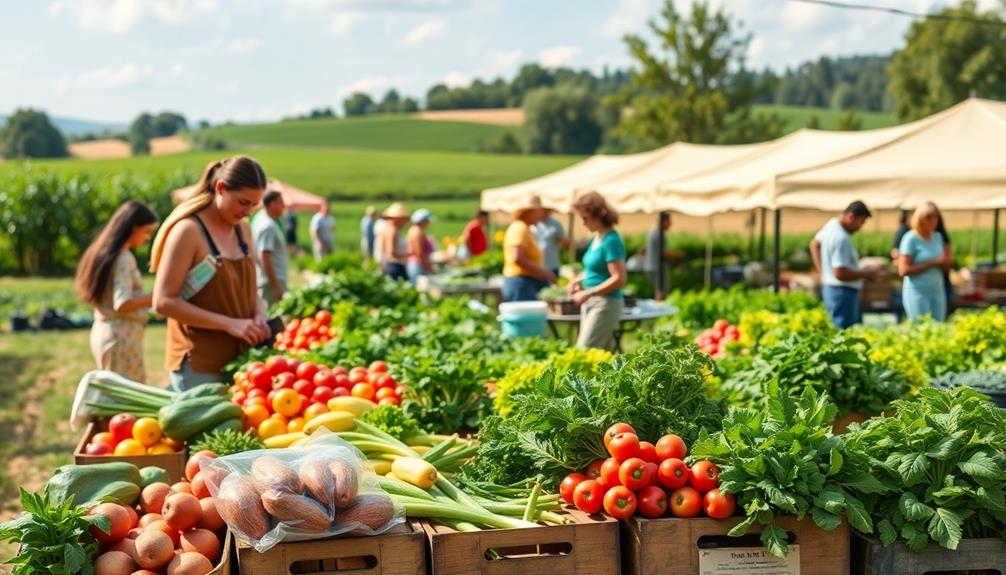
Often overlooked, local food systems play an essential role in building resilience against the challenges posed by climate change. By fostering shorter food supply chains, you can mitigate the risks associated with global trade dependencies that are increasingly vulnerable to climate disruptions. Local sourcing allows you to build direct relationships with farmers, ensuring you have access to fresher, higher-quality ingredients while supporting your local economy.
Here's how local food systems enhance resilience:
| Aspect | Benefits | Examples |
|---|---|---|
| Shorter Supply Chains | Reduces reliance on global trade | Direct farm-to-table sourcing |
| Community Engagement | Fosters self-sufficiency | Community gardens and food hubs |
| Sustainable Practices | Promotes eco-friendly farming | Collaboration with local hubs |
Adapting Cooking Practices
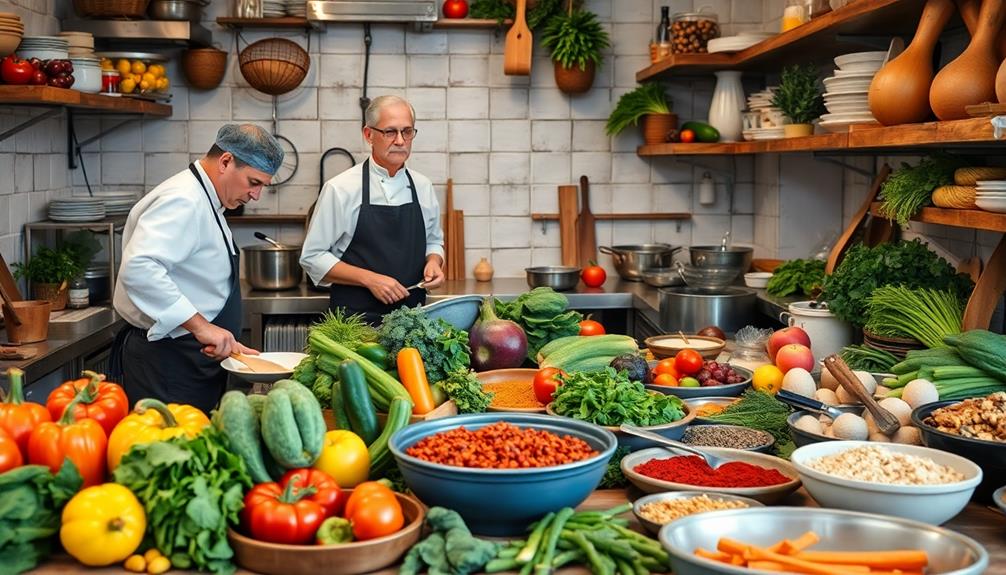
In response to the shifting landscape of food availability due to climate change, chefs are embracing innovative cooking practices that prioritize seasonal and local ingredients. This approach not only guarantees freshness but also supports resilient food systems.
You might notice restaurants diversifying their menus to include more alternative proteins and plant-based options, which help reduce reliance on vulnerable supply chains. For instance, dishes like Nettle and Potato Soup showcase the use of seasonal ingredients that are often abundant during certain times of the year.
Here are some key strategies chefs are using:
- Community-supported agriculture (CSA): By partnering with local farmers, chefs adapt their cooking to what's available, fostering sustainable relationships.
- Climate-smart cooking: Focus on ingredients that require less water and can withstand climate impacts, making your meals both delicious and eco-friendly.
- Preservation techniques: Methods like fermentation and pickling extend the shelf life of local produce, minimizing food waste and enhancing flavors.
As you navigate your own cooking, consider these practices to not only enjoy seasonal delights but also contribute to a more sustainable food future.
Embracing these changes can make a significant impact on your culinary experience and the environment.
Sustainable Food Choices
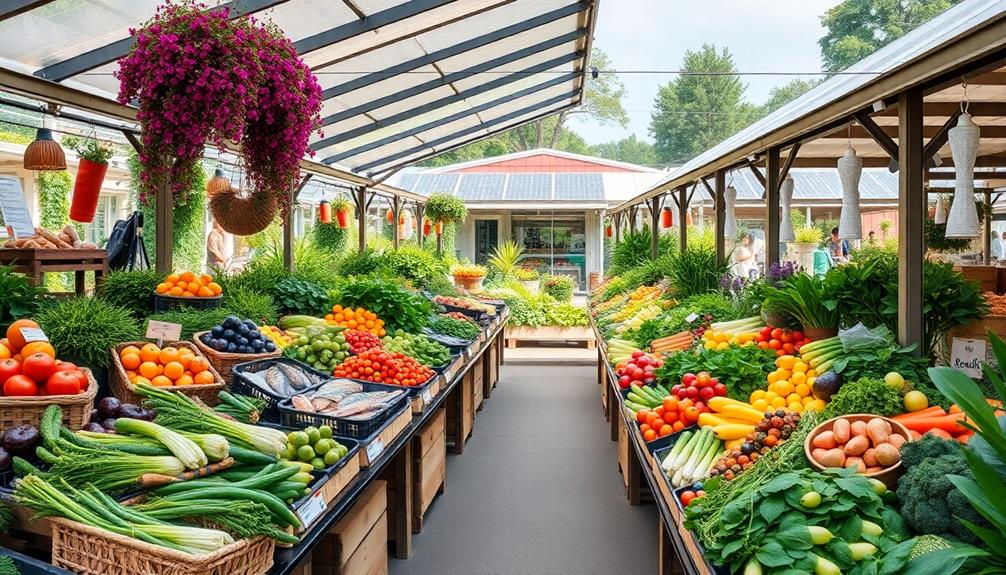
When you shift to a plant-based diet, you greatly cut down on greenhouse gas emissions and promote better health at the same time.
Incorporating traditional dishes like Muamba De Galinha can help maintain cultural heritage while embracing more sustainable ingredients.
Sourcing your food locally not only reduces transportation emissions but also strengthens your community's economy.
Plant-Based Diet Benefits
Shifting to a plant-based diet offers significant benefits for both the environment and your health. By opting for more plant-rich foods, you can drastically reduce greenhouse gas emissions—studies suggest this shift could cut food-related emissions by up to 70%.
Traditional dishes like Khao Niao Sangkhaya highlight how delicious and satisfying plant-based options can be. Not only does this help combat climate change, but it also minimizes the environmental impacts tied to food production, as plant-based foods require less energy, land, and water compared to animal-based options.
Here are some key benefits of a plant-based diet:
- Enhanced Nutrient Diversity: Plant foods are rich in essential vitamins and minerals often missing in diets heavy in animal products.
- Improved Food Security: Reducing reliance on resource-intensive livestock farming helps promote food security, especially as climate change threatens agriculture.
- Lower Greenhouse Gas Emissions: With red meat and dairy contributing to 14.5% of global emissions, cutting back on these foods is essential for climate action.
Embracing a plant-based diet not only supports your health but also plays an important role in creating a more sustainable future for our planet.
Local Sourcing Advantages
Local sourcing brings a wealth of advantages that can greatly enhance the sustainability of your food choices. By sourcing ingredients from local farms, you reduce your dependency on fragile global supply chains, which are particularly vulnerable to climate change disruptions. This direct relationship with farmers not only guarantees fresher, higher-quality produce but also strengthens food security in your community.
For instance, using locally sourced ingredients allows restaurants to incorporate traditional dishes like Kue Putu, celebrating regional flavors while supporting local economies.
When you opt for local sourcing, you shorten supply chains, which helps mitigate transportation emissions and environmental impacts. As a result, your restaurant can lower its carbon footprint while promoting sustainable practices within the food industry. Supporting small farms empowers equitable food production systems and fosters a strong community identity, both crucial for building resilience against climate challenges.
Moreover, these local connections create a vibrant culinary landscape that reflects the unique flavors and traditions of your area. By prioritizing local sourcing, you contribute to a more sustainable food system that benefits your business, your community, and the planet.
Embrace these advantages, and you'll not only enhance the quality of your offerings but also play a significant role in shaping a more sustainable future for all.
Community Engagement and Action

You can make a real difference in your community by embracing local food initiatives and participating in collaborative community gardens.
Engaging with traditional dishes like Yekolo (Roasted Barley) not only promotes cultural heritage but also highlights sustainable practices.
Educational workshops focused on sustainability empower you to understand the impact of climate change on your food choices.
Local Food Initiatives
Community-driven food initiatives are paving the way for a more sustainable future, connecting people with the sources of their nourishment. By engaging in local food initiatives like community gardens and food hubs, you can help strengthen your community's resilience against climate impacts.
These efforts not only promote fresh produce but also enhance food security, especially for vulnerable populations. Additionally, incorporating traditional dishes such as squash casserole can inspire community cooking events that celebrate local flavors and foster culinary heritage.
Here are three key benefits of participating in local food initiatives:
- Supports self-sufficiency: Getting involved in local food production encourages self-reliance, lowering dependency on global supply chains.
- Promotes sustainable agricultural practices: Collaborative efforts in these initiatives lead to improved soil health and biodiversity, contributing to long-term climate adaptation.
- Strengthens community ties: Building direct relationships between farmers and consumers fosters a sense of community and shared responsibility.
Educational Workshops for Sustainability
Through engaging educational workshops, communities can harness the power of sustainability to make a tangible impact on their food systems. These workshops empower you to adopt eco-friendly cooking practices that notably reduce food-related greenhouse gas emissions. By collaborating with local farmers and food hubs, you can build direct relationships that promote the benefits of sourcing local ingredients, enhancing food security.
Here's a glimpse of what you can expect from these workshops:
| Workshop Focus | Benefits |
|---|---|
| Sourcing Local Ingredients | Supports local economies and reduces carbon footprint |
| Plant-Based Diets | Lowers environmental impact of food consumption |
| Minimizing Food Waste | Teaches meal planning and composting, addressing 8% of global emissions |
| Hands-On Cooking Classes | Encourages practical skills and community engagement |
| Sustainable Recipe Sharing | Raises awareness about food production's climate impacts |
Collaborative Community Gardens
In the heart of neighborhoods, collaborative community gardens thrive as vibrant spaces for residents to unite in the fight against climate change. These gardens not only enhance local food production but also foster relationships among community members.
By participating, you can help mitigate the impact of climate change on food security while learning sustainable practices firsthand. Engaging in these gardens can also promote the cultivation of diverse crops, much like the variety found in traditional Korean dishes, such as kimchi, which showcases the importance of local ingredients.
Engaging in collaborative community gardens offers you several benefits:
- Educational Opportunities: Learn about the effects of climate change on agriculture and local food systems.
- Resilience Building: Contribute to reducing transportation emissions and create a more resilient local food system.
- Social Cohesion: Empower vulnerable populations by bringing diverse community members together to take action against climate threats.
These gardens often implement climate-smart practices like water conservation and soil health management.
Frequently Asked Questions
How Does Global Climate Change Affect Food?
Global climate change impacts food by altering crop yields, increasing extreme weather events, and threatening food security. You'll notice rising food prices and changing availability of ingredients as these environmental shifts continue to unfold.
How Does Climate Affect Cuisine?
Like a painter's palette, climate affects cuisine by altering ingredient availability. You'll notice flavors change, recipes adapt, and local sourcing grows essential. Chefs embrace innovation, ensuring your meals remain vibrant and reflective of their origins.
What Are the Factors Affecting Global Cuisine?
Various factors affect global cuisine, like cultural influences, ingredient availability, health trends, and technological advancements. You'll notice how local traditions shape dishes and how global interactions create a fusion of flavors across different regions.
How Global Climate Change Affect the Food Chain Ecosystem?
You might think climate change doesn't impact your meals, but it does. Unpredictable weather disrupts crops and livestock, affecting availability and prices. This ripple effect can challenge your access to diverse, nutritious foods in everyday life.
Conclusion
As you explore how climate change impacts global cuisine, consider the theory that your food choices can influence the planet's future. By embracing sustainable practices and supporting local farmers, you can help combat the adverse effects of climate change on agriculture and culinary traditions. Every meal you prepare is a chance to make a difference. So, the next time you sit down to eat, think about how your plate can reflect a commitment to a healthier planet.
